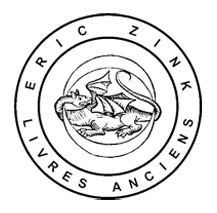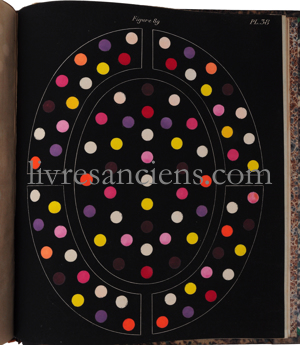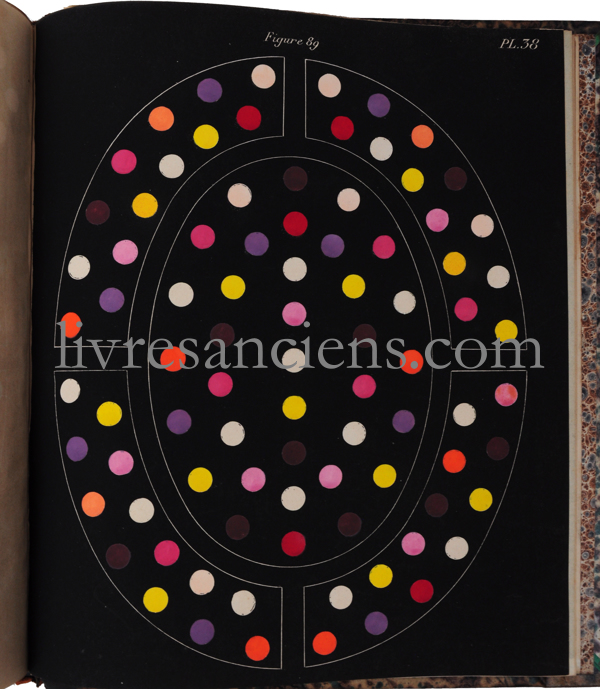

CHEVREUL, De la Loi du Contraste simultané des Couleurs, 1839

CHEVREUL, Michel Eugène.
De la Loi du Contraste simultané des Couleurs et de l’Assortiment des Objets colorés, considéré d’après cette Loi dans ses Rapports avec la Peinture, les Tapisseries des Gobelins, les Tapisseries de Beauvais pour Meubles, les Tapis, la Mosaïque, les Vitraux colorés, l’Impression des Étoffes, l’Imprimerie, l’Enluminure, la Décoration des Édifices, l’Habillement et l’Horticulture.
Paris, Pitois-Levrault, 1839.
- Atlas : 4to (270x238 mm), (2)-2 pages, (9) specimens of printing on different coloured papers and 40 plates (on 22 leaves)
- Text (211x123 mm), xv-(1 bl.)-735 pages and 2 folding tables. binding : Contemporary quarter calf, slighly different. Joint rubbed, spine chipped. Minor foxings.

First edition.
One of the most influential books on art in the 19th century.
Michel-Eugène Chevreul (1786–1889) is known to chemists for his research on fatty substances (1810–1823) and on immediate organic analysis (1824), but it is as a color theorist that his name achieved lasting fame.
De la loi du contraste simultané des couleurs introduced a scientific understanding of color that had a profound and lasting impact on the painters of his time.
His “law” describes how the perception of a hue is altered by the surrounding colors, each color projecting its complementary onto its immediate environment (thus, a red object tends to cast a greenish glow on nearby surfaces, a yellow one a purplish tint, and so on). This principle is clearly illustrated in plate 7 of the Atlas, where colored dots on a white background seem to emit halos of their complementary hues.
Eugène Delacroix (1798–1863), a central figure of Romanticism, paid close attention to Chevreul’s research. According to the painter Paul Signac, Delacroix even sought to meet the chemist and acquired notes from his lectures in order to better grasp the law of simultaneous contrast. Several of his paintings feature harmonies built around complementary color pairs. For instance, The Entry of the Crusaders into Constantinople (1840) deliberately juxtaposes yellow/purple, blue/orange, and red/green to dramatize the scene—so effectively that art historian Lee Johnson called it an ideal “illustration” of Chevreul’s treatise.
But it was arguably within the Impressionist movement that Chevreul’s theories reached their highest artistic fulfillment. Claude Monet (1840–1926), in particular, used simultaneous contrast to heighten luminosity in his landscapes. He avoided black and earth tones, preferring instead to render shadows in color: purples and blues for shaded areas at sunset, accented with yellow-orange highlights in full light. This technique appears as early as Impression, Sunrise, the foundational work of the movement. One might also recall the poppy fields, a favorite motif of the Impressionists (Van Gogh, Monet, Pissarro…), where red flowers vibrantly stand out against green backgrounds.
A book heralding one of the greatest revolutions in painting.
Our copy is complete with all the color plates, most of them signed by Chevreul himself.
references: Norman [469], En Français dans le Texte [237 : "Chevreul, énonce des principes, notamment ceux de la décomposition des tons et de la juxtaposition des couleurs pures, qui exerceront une influence considérable sur les peintres impressionistes."], George Roque ["Chevreul's colour theory and its consequences for artists, 2010 : "Chevreul published a plate that made a deep impression on painters (Plate 7), showing how on a white ground, when we stare at small disks of pure colours, we perceive a fringe effect as a halo of the complementary colour all around the disk [...] as they wanted to enhance their colours, they used the law of simultaneous colours that they applied in numerous paintings."].
Price : 9000 €



















